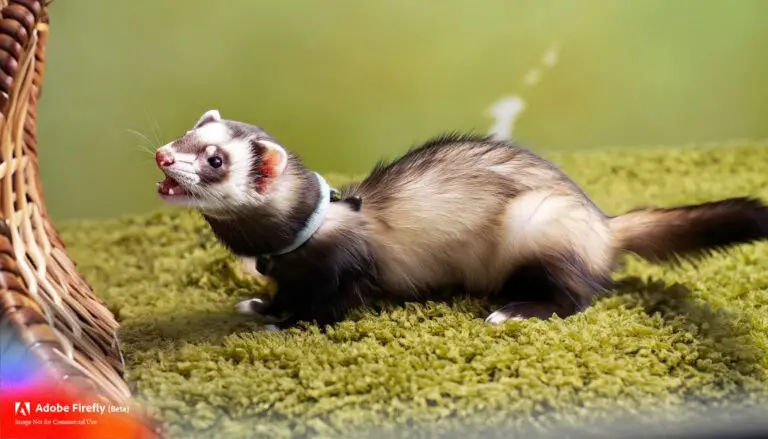
Are rats and ferrets related? This is a question that often comes up when discussing these two furry creatures. While they may share some similarities in appearance and behavior, the truth is that rats and ferrets are not closely related at all. In fact, they belong to completely different families within the animal kingdom.
Rats belong to the family Muridae, which includes various species of rodents. On the other hand, ferrets belong to the family Mustelidae, which includes carnivorous mammals like weasels and otters. Despite their distinct family ties, rats and ferrets do have some overlapping traits, such as their ability to adapt to various environments and their curious nature.
Let’s address the question of whether ferrets attract rats. While it is true that ferrets are skilled hunters and have a strong sense of smell, there is no evidence to suggest that they specifically attract rats. In fact, ferrets are often used as pest control animals precisely because of their hunting abilities. However, it’s important to note that ferrets should never be used as a substitute for proper pest control methods in dealing with a rat infestation.
In conclusion, rats and ferrets may share a few similarities, but they are not closely related. Additionally, while ferrets are skilled hunters, they do not attract rats. Understanding the differences between these two animals can help us appreciate their unique qualities and roles in the animal kingdom.
Are Rats and Ferrets Related?
When it comes to the question of whether rats and ferrets are related, the answer is no. While they may share some similarities in appearance and behavior, they actually belong to different families and have distinct genetic lineages.
Rats, specifically the common brown rat, belong to the family Muridae, which includes rodents. These intelligent creatures are known for their adaptability and have a long history of coexistence with humans. Rats have a sharp sense of smell and are excellent climbers, making them successful in urban environments.
On the other hand, ferrets belong to the family Mustelidae, which includes carnivorous mammals. They are closely related to animals such as otters, weasels, and badgers. Ferrets have a sleek and elongated body, making them well-suited for hunting small prey. These playful and curious animals are often kept as pets and are valued for their entertaining nature.
While rats and ferrets may have some behavioral similarities, such as their ability to burrow and explore, their genetic differences are clear. It’s important to distinguish between the two and not assume that they are closely related.
Understanding the distinct relationship between rats and ferrets is crucial for appreciating their unique qualities and roles in the animal kingdom. By recognizing their genetic differences, we can better understand and appreciate the diversity of life on our planet.
Differences in Family Ties
When it comes to family ties, rats and ferrets may share some similarities in appearance and behavior, but they actually belong to different families in the animal kingdom. Rats fall under the family Muridae, while ferrets are part of the family Mustelidae. Understanding these genetic differences is crucial in appreciating the unique qualities and roles that rats and ferrets play in their respective ecosystems.
Adaptability is a key trait that distinguishes rats. They are incredibly resourceful creatures that have successfully adapted to various environments around the world. Rats are known for their ability to thrive in both urban and rural settings, making them one of the most adaptable mammal species. Their intelligence and ability to problem-solve contribute to their survival skills, allowing them to navigate and exploit environments that may be challenging for other creatures.
On the other hand, ferrets possess a sleek and elongated body that is well-suited for their natural hunting instincts. They belong to a family of carnivorous mammals known for their agility and predatory capabilities. Ferrets have shorter legs and a long slender body, allowing them to easily maneuver through tight spaces and burrows in search of their prey. Their sharp teeth and claws, combined with their hunting instincts, make them formidable predators in their ecosystem.
While rats and ferrets may not be closely related in terms of family ties, it is essential to understand and appreciate the unique characteristics of each animal. Both rats and ferrets play important roles in the balance of their respective ecosystems. Rats, with their adaptability and intelligence, contribute to the recycling of nutrients and serve as a food source for various predators. Ferrets, with their hunting abilities, help control populations of small mammals and contribute to the overall ecosystem health.
The differences in family ties between rats and ferrets highlight the diverse nature of the animal kingdom. Each species has its own unique qualities and adaptations that allow them to thrive in their distinct environments. It is important to recognize and appreciate these differences to truly understand and protect the natural world around us.
Similarities in Appearance and Behavior
When it comes to the appearance and behavior of rats and ferrets, there are some interesting similarities to explore. Despite belonging to different families in the animal kingdom, rats and ferrets share a few common traits that have attracted the attention of researchers and animal enthusiasts alike.
Physical Traits
At first glance, one can notice some similarities between rats and ferrets in terms of their physical appearance. Both animals have long and flexible bodies with sleek fur. While rats have a cylindrical body shape, ferrets have a more elongated body, which allows them to move swiftly and stealthily. This streamlined physique makes ferrets well-suited for hunting and capturing prey.
Facial Characteristics
Another shared feature between rats and ferrets can be observed in their facial structures. Both animals have a similar facial shape, with small, rounded ears and a pointed snout. Additionally, they both possess sharp teeth and claws, which they use for various purposes. However, it’s worth noting that rats have a more prominent nose compared to ferrets, reflecting their excellent sense of smell.
Social Behavior
In terms of behavior, both rats and ferrets exhibit social tendencies and live in hierarchical groups. Rats, in particular, are known for their highly social nature, living in colonies and forming strong bonds with their fellow rats. They display complex communication and cooperation skills within their social groups. On the other hand, ferrets are also social animals to some extent, but they are more solitary in nature, preferring to live in pairs or small groups.
Curiosity and Intelligence
Lastly, rats and ferrets share a commendable level of curiosity and intelligence. Rats, in particular, are renowned for their problem-solving abilities and adaptability to various environments. They are incredibly resourceful creatures, capable of learning and navigating complex mazes. Similarly, ferrets are known for their cunning hunting skills, using their intelligence and agility to catch their prey.
Despite belonging to different families, rats and ferrets display noticeable similarities in their appearance and behavior. From their physical traits to their social tendencies and cognitive abilities, these animals share common characteristics that make them fascinating creatures to study and appreciate. By understanding these similarities, we can gain a deeper appreciation for the diverse nature of the animal kingdom.
Are Ferrets Attracting Rats?
As a seasoned researcher in the animal kingdom, I often come across intriguing questions about various species. One question that frequently arises is whether ferrets attract rats. Let’s dive into this topic and explore the relationship between these two fascinating creatures.
Contrary to popular belief, ferrets do not attract rats. In fact, rats and ferrets belong to different families in the animal kingdom and have distinct characteristics that set them apart. Rats are part of the family Muridae, while ferrets belong to the family Mustelidae. These differences in their genetic makeup make it highly unlikely that ferrets would directly attract rats.
Rats and ferrets have different ecological roles and occupy different niches within their respective ecosystems. Rats, with their resourcefulness and adaptability, thrive in various environments, from urban areas to rural settings. They are highly skilled at finding food sources and tend to be attracted to areas where they can easily access food, water, and shelter. This can sometimes create an environment that appears attractive to rats.
On the other hand, ferrets are agile predators with sharp teeth and claws, making them well-suited for hunting. They play a role in controlling populations of small mammals, including rats. In an ecosystem where ferrets are present, their predation can actually help regulate rat populations.
It is also essential to understand the root cause of a potential rat problem. Factors such as poor sanitation, food availability, and building design can contribute to rat infestations. While ferrets may be present in the environment and have an impact on rat populations, they are not the main attractant for rats.
Remember, when it comes to rats and ferrets, genetic differences, ecological roles, and environmental factors are key factors to consider. By understanding these intricacies, we can dispel misconceptions and develop informed opinions about the relationship between rats and ferrets.
So, when you come across claims about ferrets attracting rats, remember that rats and ferrets have unique attributes that separate them from one another. They may coexist in certain ecosystems, but ferrets are not the primary cause of rat attraction.
Ferrets as Pest Control Animals
When it comes to pest control, ferrets have gained popularity as effective predators, particularly in situations where smaller mammals like rats need to be controlled. Due to their natural instincts as skilled hunters, ferrets can play a significant role in reducing rat populations. Here’s why ferrets are often seen as pest control animals:
- Agility and Hunting Skills: Ferrets are highly agile animals with sharp claws and teeth. They are quick and efficient hunters, capable of chasing down and capturing small mammals like rats. Their slender body and flexible spine allow them to access narrow spaces where rodents often hide.
- Natural Instincts: Ferrets have an innate ability to hunt. Their predatory instincts make them natural enemies of rats and other small mammals. They are exceptionally skilled at tracking, pursuing, and capturing their prey, which includes rats. This makes them a valuable asset in controlling rat populations.
- Fearlessness: Ferrets possess a fearless nature that allows them to confront and combat rats without hesitation. Unlike humans who might be intimidated by rats, ferrets approach them head-on. This courage, combined with their hunting abilities, makes them an efficient tool in pest control efforts.
- Versatility in Environments: Ferrets are adaptable animals that can thrive in various environments. From residential homes to farms, ferrets can be trained to hunt rats wherever the need arises. Their versatility ensures that they can be utilized in different scenarios, making them an asset in pest management.
It’s important to note that while ferrets can be effective in reducing rat populations, they should be used in conjunction with other pest control measures. Factors such as poor sanitation, food availability, and building design all contribute to rat infestations. By addressing these root causes, and utilizing the natural hunting abilities of ferrets, a comprehensive pest control strategy can be implemented and tailored to the specific needs of the environment.
Conclusion
Rats and ferrets are not closely related in the animal kingdom. They belong to different families and have distinct characteristics that set them apart. While rats are resourceful and adaptable creatures that thrive in various environments, ferrets are agile predators that play a crucial role in controlling populations of small mammals, including rats.
Although ferrets are often seen as effective pest control animals, they are not the main attractant for rats. Factors such as poor sanitation, food availability, and building design contribute to rat infestations. Ferrets can have an impact on rat populations due to their agility, hunting skills, natural instincts, fearlessness, and versatility in capturing rats.
However, it is important to note that while ferrets can be effective in reducing rat populations, they should be used in conjunction with other pest control measures. Addressing the root causes of rat infestations, such as improving sanitation and eliminating food sources, is essential for long-term rat control.
Overall, understanding the differences between rats and ferrets and implementing comprehensive pest control strategies is key to managing rat infestations effectively.






